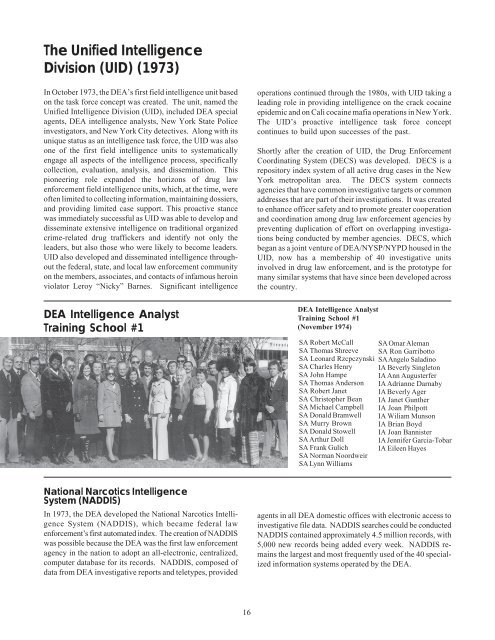Download This File - The Free Information Society
Download This File - The Free Information Society
Download This File - The Free Information Society
Create successful ePaper yourself
Turn your PDF publications into a flip-book with our unique Google optimized e-Paper software.
<strong>The</strong> Unified Intelligence<br />
Division (UID) (1973)<br />
In October 1973, the DEA’s first field intelligence unit based<br />
on the task force concept was created. <strong>The</strong> unit, named the<br />
Unified Intelligence Division (UID), included DEA special<br />
agents, DEA intelligence analysts, New York State Police<br />
investigators, and New York City detectives. Along with its<br />
unique status as an intelligence task force, the UID was also<br />
one of the first field intelligence units to systematically<br />
engage all aspects of the intelligence process, specifically<br />
collection, evaluation, analysis, and dissemination. <strong>This</strong><br />
pioneering role expanded the horizons of drug law<br />
enforcement field intelligence units, which, at the time, were<br />
often limited to collecting information, maintaining dossiers,<br />
and providing limited case support. <strong>This</strong> proactive stance<br />
was immediately successful as UID was able to develop and<br />
disseminate extensive intelligence on traditional organized<br />
crime-related drug traffickers and identify not only the<br />
leaders, but also those who were likely to become leaders.<br />
UID also developed and disseminated intelligence throughout<br />
the federal, state, and local law enforcement community<br />
on the members, associates, and contacts of infamous heroin<br />
violator Leroy “Nicky” Barnes. Significant intelligence<br />
operations continued through the 1980s, with UID taking a<br />
leading role in providing intelligence on the crack cocaine<br />
epidemic and on Cali cocaine mafia operations in New York.<br />
<strong>The</strong> UID’s proactive intelligence task force concept<br />
continues to build upon successes of the past.<br />
Shortly after the creation of UID, the Drug Enforcement<br />
Coordinating System (DECS) was developed. DECS is a<br />
repository index system of all active drug cases in the New<br />
York metropolitan area. <strong>The</strong> DECS system connects<br />
agencies that have common investigative targets or common<br />
addresses that are part of their investigations. It was created<br />
to enhance officer safety and to promote greater cooperation<br />
and coordination among drug law enforcement agencies by<br />
preventing duplication of effort on overlapping investigations<br />
being conducted by member agencies. DECS, which<br />
began as a joint venture of DEA/NYSP/NYPD housed in the<br />
UID, now has a membership of 40 investigative units<br />
involved in drug law enforcement, and is the prototype for<br />
many similar systems that have since been developed across<br />
the country.<br />
DEA Intelligence Analyst<br />
DEA Intelligence Analyst Training School #1<br />
Training School #1<br />
(November 1974)<br />
SA Robert McCall SA Omar Aleman<br />
SA Thomas Shreeve SA Ron Garribotto<br />
SA Leonard Rzcpczynski SA Angelo Saladino<br />
SA Charles Henry IA Beverly Singleton<br />
SA John Hampe IA Ann Augusterfer<br />
SA Thomas Anderson IA Adrianne Darnaby<br />
SA Robert Janet IA Beverly Ager<br />
SA Christopher Bean IA Janet Gunther<br />
SA Michael Campbell IA Joan Philpott<br />
SA Donald Bramwell IA Wiliam Munson<br />
SA Murry Brown IA Brian Boyd<br />
SA Donald Stowell IA Joan Bannister<br />
SA Arthur Doll IA Jennifer Garcia-Tobar<br />
SA Frank Gulich IA Eileen Hayes<br />
SA Norman Noordweir<br />
SA Lynn Williams<br />
National Narcotics Intelligence<br />
System (NADDIS)<br />
In 1973, the DEA developed the National Narcotics Intelligence<br />
System (NADDIS), which became federal law<br />
enforcement’s first automated index. <strong>The</strong> creation of NADDIS<br />
was possible because the DEA was the first law enforcement<br />
agency in the nation to adopt an all-electronic, centralized,<br />
computer database for its records. NADDIS, composed of<br />
data from DEA investigative reports and teletypes, provided<br />
16<br />
agents in all DEA domestic offices with electronic access to<br />
investigative file data. NADDIS searches could be conducted<br />
NADDIS contained approximately 4.5 million records, with<br />
5,000 new records being added every week. NADDIS remains<br />
the largest and most frequently used of the 40 specialized<br />
information systems operated by the DEA.

















